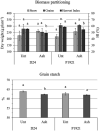Effects of Soil Amendment With Wood Ash on Transpiration, Growth, and Metal Uptake in Two Contrasting Maize (Zea mays L.) Hybrids to Drought Tolerance
- PMID: 34093619
- PMCID: PMC8173060
- DOI: 10.3389/fpls.2021.661909
Effects of Soil Amendment With Wood Ash on Transpiration, Growth, and Metal Uptake in Two Contrasting Maize (Zea mays L.) Hybrids to Drought Tolerance
Abstract
Wood ash as a soil amendment has gained wide spread acceptance in the recent years as a sustainable alternative to chemical fertilizers, although information regarding the effects of its application on maize growth and yield in the context of climate change and increasing drought severity is lacking till date. In the present study, field and pot trials were carried out at the experimental farm of the University of Padova at Legnaro (NE Italy) in a silty-loam soil in order to investigate the effects of soil amendment with wood ash (0.1% w/w, incorporated into the 0.2-m top soil) on the bioavailability of mineral elements and their uptake by maize. Characteristics analyzed included plant growth, leaf transpiration dynamics, and productivity in two contrasting hybrids, P1921 (drought sensitive) and D24 (drought tolerant). Wood ash contained relevant amounts of Ca, K, Mg, P, and S, and hazardous levels of Zn (732 mg kg-1), Pb (527 mg kg-1), and Cu (129 mg kg-1), although no significant changes in total soil element concentration, pH, and electrical conductivity were detected in open field. Ash application led to a general increasing trend of diethylene triamine penta-acetic acid (DTPA)-extractable of various elements, bringing to higher grain P in D24 hybrid, and Zn and Ni reductions in P1921 hybrid. Here, the results demonstrated that ash amendment enhanced shoot growth and the number of leaves, causing a reduction of harvest index, without affecting grain yield in both hybrids. The most relevant result was a retarded inhibition of leaf transpiration under artificial progressive water stress, particularly in the drought-tolerant D24 hybrid that could be sustained by root growth improvements in the field across the whole 0-1.5 m soil profile in D24, and in the amended top soil in P1921. It is concluded that woody ash can be profitably exploited in maize fertilization for enhancing shoot and root growth and drought tolerance, thanks to morphological and physiological improvements, although major benefits are expected to be achieved in drought tolerant hybrids. Attention should be payed when using ash derived by metal contaminated wood stocks to avoid any health risk in food uses.
Keywords: corn; drought tolerance; leaf transpiration; nutrient availability and uptake; phenolic acids; progressive water stress; root growth; wood ash.
Copyright © 2021 Romdhane, Ebinezer, Panozzo, Barion, Dal Cortivo, Radhouane and Vamerali.
Conflict of interest statement
The authors declare that the research was conducted in the absence of any commercial or financial relationships that could be construed as a potential conflict of interest.
Figures






References
-
- Adekayode F. O., Olojugba M. R. (2010). The utilization of wood ash as manure to reduce the use of mineral fertilizer for improved performance of maize (Zea mays L.) as measured in the chlorophyll content and grain yield. J. Soil Sci. Environ. Manage. 1, 40–45. 10.5897/JSSEM.9000079 - DOI
-
- Arshad M. A., Soon Y. K., Azooz R. H., Lupwayi N. Z., Chang S. X. (2012). Soil and crop response to wood ash and lime application in acidic soils. Agron. J. 104, 715–721. 10.2134/agronj2011.0355 - DOI
LinkOut - more resources
Full Text Sources
Research Materials
Miscellaneous

